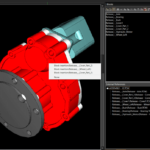Computer Integrated Manufacturing (CIM) encompasses the entire range of product development and manufacturing activities with all the functions being carried out with the help of dedicated software packages. The data required for various functions are passed from one application software to another in a seamless manner. For example, the product data is created during design. This data has to be transferred from the modelling software to manufacturing software without any loss of data. CIM uses a common database wherever feasible and communication technologies to integrate design, manufacturing and associated business functions that combine the automated segments of a factory or a manufacturing facility. CIM reduces the human component of manufacturing and thereby relieves the process of its slow, expensive and error-prone component. CIM stands for a holistic and methodological approach to the activities of the manufacturing enterprise in order to achieve vast improvement in its performance.
This methodological approach is applied to all activities from the design of the product to customer support in an integrated way, using various methods, means and techniques in order to achieve production improvement, cost reduction, fulfilment of scheduled delivery dates, quality improvement and total flexibility in the manufacturing system. CIM requires all those associated with a company to involve totally in the process of product development and manufacture. In such a holistic approach, economic, social and human aspects have the same importance as technical aspects. CIM also encompasses the whole lot of enabling technologies including total quality management, business process reengineering, concurrent engineering, workflow automation, enterprise resource planning and flexible manufacturing.
Manufacturing industries strive to reduce the cost of the product continuously to remain competitive in the face of global competition. In addition, there is the need to improve the quality and performance levels on a continuing basis. Another important requirement is on time delivery. In the context of global outsourcing and long supply chains cutting across several international borders, the task of continuously reducing delivery times is really an arduous task. CIM has several software tools to address the above needs.
Manufacturing engineers are required to achieve the following objectives to be competitive in a global context.
· Reduction in inventory
· Lower the cost of the product
· Reduce waste
· Improve quality
· Increase flexibility in manufacturing to achieve immediate and rapid response to:
§ Product changes
§ Production changes
§ Process change
§ Equipment change
§ Change of personnel
CIM technology is an enabling technology to meet the above challenges to the manufacturing.


